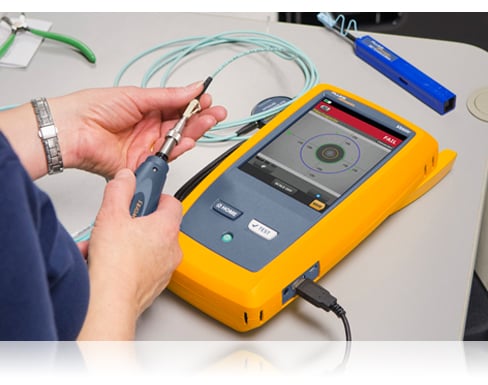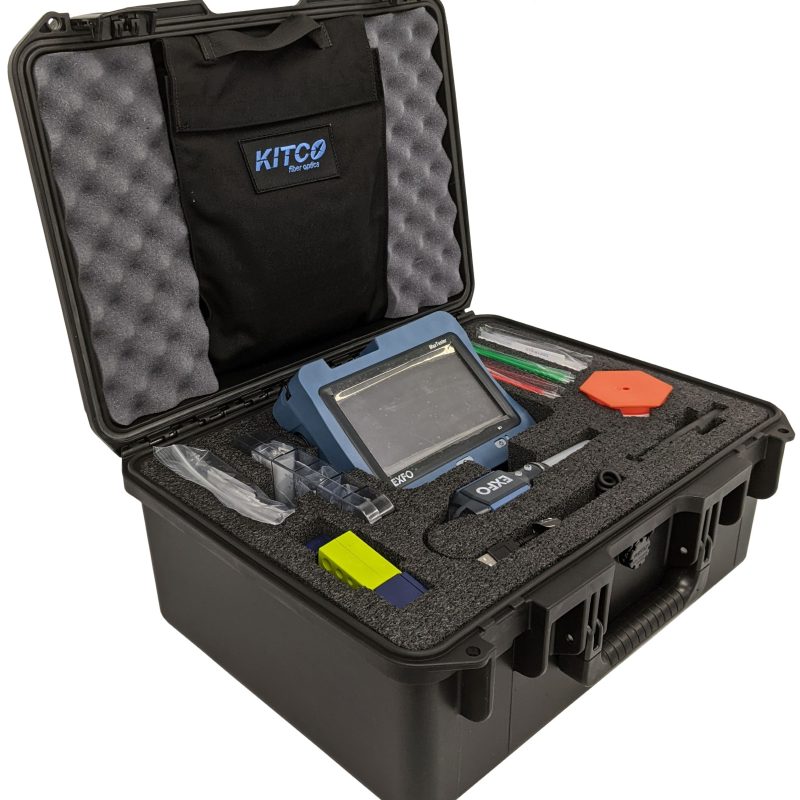Future trends in fibre testing equipment for broadband expansion
Wiki Article
Discovering the Impact of Robotic Vision on Modern Production Techniques and Quality Assurance
Robotic vision modern technology is changing the landscape of modern manufacturing and high quality control. By incorporating advanced imaging systems and expert system, makers can achieve unmatched degrees of precision and performance. This change not just optimizes production processes but likewise addresses essential challenges in maintaining product standards. As industries increasingly rely on these developments, the ramifications for future manufacturing practices remain to be fully explored. What will this mean for the competitive characteristics of the marketplace?Recognizing Robotic Vision Innovation
Robotic vision innovation acts as the backbone of automation in modern production. It incorporates making use of cams, sensors, and synthetic intelligence to make it possible for robotics to translate and respond to aesthetic info from their atmosphere. This technology permits robotics to identify, locate, and review things, making them capable of performing intricate jobs such as assembly, examination, and product handling with precision. The assimilation of artificial intelligence formulas additionally enhances the capacity of robotic vision systems, permitting them to adapt to differing problems and improve in time. By processing pictures and information in real-time, robotic vision systems can facilitate much faster decision-making and decrease mistakes in producing processes (optical fibre diameter analyser). This innovation not just improves operational effectiveness but likewise guarantees that high quality criteria are satisfied continually. As the manufacturing landscape proceeds to evolve, comprehending the intricacies of robotic vision modern technology becomes crucial for leveraging its potential completelyAdvantages of Robotic Vision in Manufacturing
Robotic vision innovation uses significant benefits in manufacturing by improving accuracy and precision in tasks such as high quality control and setting up. This raised level of detail assurances that items fulfill stringent standards, minimizing waste and revamp. In addition, the integration of robotic vision can result in boosted manufacturing performance, allowing producers to enhance their processes and accomplish higher outcome prices.Boosted Precision and Accuracy
In modern-day production, boosted precision and accuracy are essential for enhancing production processes and guaranteeing product high quality. Robotic vision systems allow devices to carry out complicated tasks with remarkable consistency. These systems make use of sophisticated imaging technologies to find minute details and variants in products, components, and finished items. By evaluating aesthetic data in real-time, robot vision substantially lowers human error, resulting in less problems and better requirements. Furthermore, enhanced precision in measurements and placing facilitates much better positioning in assembly procedures, which is necessary for complex designs. Eventually, the integration of robotic vision not just reinforces the integrity of making outcomes but additionally promotes self-confidence among consumers pertaining to product honesty and performance. This accuracy is important in industries where top quality is critical.Increased Manufacturing Efficiency

Makers are increasingly transforming to vision systems to boost manufacturing efficiency across numerous processes. These sophisticated systems enable real-time assessment and tracking, substantially minimizing downtime triggered by errors or flaws. By integrating robotic vision, business can automate quality assurance, enabling for faster recognition of concerns and minimizing the requirement for human treatment. This causes structured process, as robots can promptly adjust to adjustments in production needs without sacrificing precision. Moreover, vision systems promote better inventory administration by precisely tracking parts and items, ensuring optimal source application. Ultimately, the adoption of robotic vision not just boosts performance yet additionally adds to greater outcome rates, decreased operational costs, and improved overall performance in the production field.
Enhancing Quality Assurance Processes
Robotic vision modern technology substantially improves high quality control processes in manufacturing by using accuracy assessment methods. These advanced systems facilitate real-time issue detection, guaranteeing that products fulfill rigid quality criteria. Consequently, producers can minimize waste and boost general efficiency.Precision Examination Techniques
Precision assessment techniques have actually revolutionized high quality control processes in production, enabling the detection of minute issues that standard approaches might ignore. These strategies leverage advanced imaging innovations, such as high-resolution cameras and laser scanning, to achieve unmatched precision. By utilizing robotic vision systems, makers can automate examination jobs, making sure regular performance and reducing human error. The integration of machine knowing algorithms in addition boosts these systems, allowing them to adapt and boost over time. In addition, precision inspection helps with the identification of subtle variations in item measurements and surface area finishes, which can substantially affect overall product quality. As a result, suppliers can apply corrective actions extra quickly, eventually resulting in reduced waste and improved customer satisfaction.Real-Time Issue Detection
Harnessing innovative imaging modern technologies, real-time defect detection changes quality assurance processes in manufacturing. By integrating high-resolution cameras and sophisticated formulas, makers can swiftly recognize anomalies throughout production. This innovation helps with immediate corrective actions, reducing waste and enhancing total performance. Real-time systems analyze products as they move along the production line, making sure that issues are spotted and addressed without delaying production timetables. On top of that, the implementation of equipment learning improves the precision of these systems, permitting them to adjust to new flaw patterns over time. Subsequently, manufacturers take advantage of enhanced item quality and lowered functional prices. Eventually, real-time defect detection not only simplifies processes yet also cultivates a society of continuous improvement in modern-day manufacturing atmospheres.Real-Time Data Analysis and Choice Making
In the dynamic landscape of manufacturing, real-time data analysis equips systems to make swift, educated choices. By leveraging advanced robot vision technologies, producers can gather and refine large amounts of data instantly. These systems analyze aesthetic inputs to check production procedures, making certain that any discrepancies from quality standards are detected and resolved promptly. Manufacturers can enhance procedures by reallocating resources and changing operations based on real-time understandings.In addition, the integration of information analytics permits anticipating upkeep, where possible equipment failings are prepared for before they interfere with manufacturing. This aggressive method reduces downtime and enhances overall efficiency. optical fibre diameter analyser. The ability to make data-driven choices in real time significantly reduces waste and boosts product high quality, permitting manufacturers to respond to market needs promptly. Consequently, real-time information analysis not just simplifies production yet likewise promotes a culture of continuous improvement in modern production settings
Challenges in Applying Robotic Vision Systems
Implementing robotic vision systems in producing offers a range of challenges that can prevent their efficiency. One significant obstacle is the complexity of integrating these systems with existing machinery and process. Producers often encounter compatibility issues with legacy devices, bring about raised costs and downtime. Furthermore, the variability in item forms, dimensions, and products can complicate the calibration of vision systems, necessitating extensive training and fine-tuning.Another obstacle hinges on processing large volumes of aesthetic information in actual time. High-performance computing resources are essential, which may require more financial investment in facilities. There is a shortage of knowledgeable personnel capable of handling and preserving these advanced systems, leading to potential operational inefficiencies. Finally, making sure the reliability and accuracy of robotic vision systems under differing ecological conditions presents a continuous obstacle. Resolving these concerns is important for making the most of the potential advantages of robotic vision in manufacturing.
Future Fads in Robotic Vision for Production
As improvements in expert system and artificial intelligence remain to develop, the future of robotic vision in manufacturing appears progressively encouraging. Arising trends show a shift in the direction of extra innovative imaging technologies, such as 3D vision systems and hyperspectral imaging, which will certainly boost precision in quality assurance procedures. Integration with the Web of Things (IoT) will enable real-time information analysis, allowing robot systems to adjust promptly to modifications in the manufacturing atmosphere. The development of collective robotics (cobots) outfitted with sophisticated vision abilities is expected to facilitate smooth human-robot interactions, optical fibre diameter analyser enhancing effectiveness and security on the factory floor. In addition, the incorporation of edge computer will certainly encourage robot vision systems to refine information in your area, lowering latency and making it possible for faster decision-making. These advancements will not only streamline making procedures yet likewise greatly boost product quality, positioning robotic vision as a foundation of future industrial operations.Frequently Asked Concerns
Just How Much Does Robotic Vision Technology Usually Expense?
Robotic vision modern technology normally costs in between $10,000 and $100,000, depending on the complexity and requirements. Aspects affecting cost include sensing unit top quality, software program capabilities, and integration needs, making it important to assess details task needs.What Industries Are Most Influenced by Robotic Vision Developments?
Robotic vision advancements significantly impact sectors such as production, auto, electronics, and food handling - robotic vision. These fields gain from boosted automation, boosted quality assurance, and enhanced effectiveness, leading to structured procedures and reduced labor costsCan Robotic Vision Solutions Be Integrated With Existing Equipment?
Robotic vision systems can undoubtedly be incorporated with existing equipment. This combination improves functional efficiency, permitting manufacturers to utilize advanced technologies without the need for full overhauls, thereby optimizing production procedures and maintaining high quality requirements.
What Skills Are Required to Operate Robotic Vision Solutions?
Operating robot vision systems requires efficiency in shows, an understanding of artificial intelligence, understanding of image processing methods, and the capability to fix equipment and software application problems, making sure smooth combination and optimal performance within manufacturing settings.Exist Any Type Of Security Worries With Robotic Vision in Production?

Report this wiki page